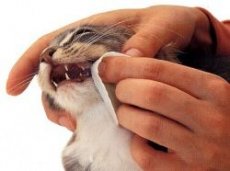Ten Steps to the Health of Cats' Teeth
Last reviewed: 19.10.2021

All iLive content is medically reviewed or fact checked to ensure as much factual accuracy as possible.
We have strict sourcing guidelines and only link to reputable media sites, academic research institutions and, whenever possible, medically peer reviewed studies. Note that the numbers in parentheses ([1], [2], etc.) are clickable links to these studies.
If you feel that any of our content is inaccurate, out-of-date, or otherwise questionable, please select it and press Ctrl + Enter.

Even if the only thing your cat is hunting for right now is pieces of fodder with chicken flavor and toy mice, she still needs clean, sharp teeth and healthy gums. Damage to the tongue, teeth, hard palate and gums can lead to many health threats to cats, but this can be prevented through regular home inspections and good old teeth cleaning.
- Breath test
Inhale. The breath should not be deep - the breathing of cats does not smell like roses, but it should not be disgusting either. If your cat's mouth has an unusually strong odor, it may have digestive problems or gum disease, for example, gingivitis, and it should be shown to a veterinarian.
- Gums and teeth
Place the cat face to you, gently push her lips apart. The gums should be firm and pink, not white or red, there should be no signs of swelling. Teeth should be clean and without brownish tartar, all teeth should be in place, there should not be broken teeth.
- Thorough examination
See if there are any of the following symptoms that may indicate problems with the oral cavity of the cat:
- Dark red line along the gums
- Red and swollen gums
- Sores on the gums and tongue
- Dropped teeth
- Pus
- Difficulty chewing food
- Increased drooling
- The cat too often touches the area of the mouth
- Dangerous inflammation
For any indication of inflammation of the gums, you should show the cat to the vet. If you do not treat gum disease, they can be aggravated and potentially lead to tooth loss and inability to eat. Inflammation can also indicate internal problems, such as kidney disease and the immunodeficiency virus of cats.
- The truth about the damage of teeth
Bacteria and food forming plaque can cause the formation of a plaque on the teeth of a cat. This can lead to tartar, potentially causing gingivitis, recession (decrease) of gums and loss of teeth. Decision? Of course, regular brushing of teeth.
- A set for cleaning your cat's teeth
All you need to clean the cat's teeth are cotton swabs, a small toothbrush and a toothpaste tube designed for cats. You can also use salt with water. Ask the veterinarian to recommend tooth cleaning supplies that he trusts, and never use a toothpaste designed for people - her ingredients may be harmful to the cat.
- How to brush your cat's teeth
Clean the cat's teeth at home, following such simple steps:
- First, teach your cat to brush your teeth. Start with a gentle massage of the gums with your fingers or by touching the gums with a cotton swab.
- After several sessions, apply a little toothpaste designed for cats, to her lips, so she gets used to her taste.
- Then, enter a brush designed specifically for cats - it will be smaller than brushes for humans, and the bristles will be softer. Also available are toothbrushes, which you can put on your finger, which will allow you to make a good gum cat massage.
- Finally, apply toothpaste on the cat's teeth and gently brush her teeth.
- An early veterinary examination will help to determine if the cat's gum is inflamed. Many cats have small gingivitis, and too hard cleansing can injure their gums.
- Chewing Toys
Chewing toys can satisfy the natural desire of a cat to gnaw by strengthening teeth. Gnawing the toys can also help to clean between the cat's teeth, massage the gums and scrape off the soft tartar.
- Diet for a healthy teeth
If your cat has problems with teeth, ask the veterinarian to recommend you a feed that supports the health of the cat's teeth and helps remove the plaque.
- What are the diseases of the oral cavity?
If your cat suffers from any of the following symptoms, immediately show it to the vet:
- Gingivitis. This inflammation of the gums is mainly observed in older cats. It can begin with a dark red line adjacent to the teeth. If it is not treated, the gums may become painful, and sores may appear. This may be a sign of the immunodeficiency virus of cats or another infection.
- Periodontitis. If gingivitis seizes the dental alveolus, the tooth may loosen, and suppuration may also occur.
- Stomatitis. This inflammation of the lining of the mouth may occur due to foreign body, viral disease or problems with the teeth. The cat will be difficult to eat, and the mouth will be red.
- Corrosive ulcer. Slowly increasing wound or swelling on the upper lip.
- Cyst of the salivary gland. If the salivary glands or ducts, through which saliva enters the mouth, are clogged, a cyst may form under the tongue.
- Ulcers in the mouth. Ulcers in the cat's tongue and gums are sometimes caused by a disease of the respiratory tract or cat's kidneys.
